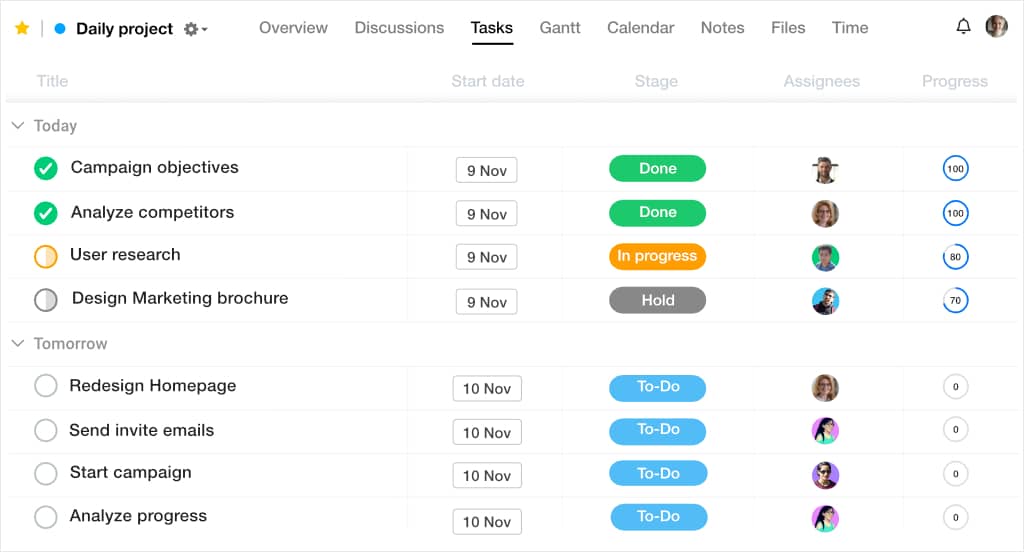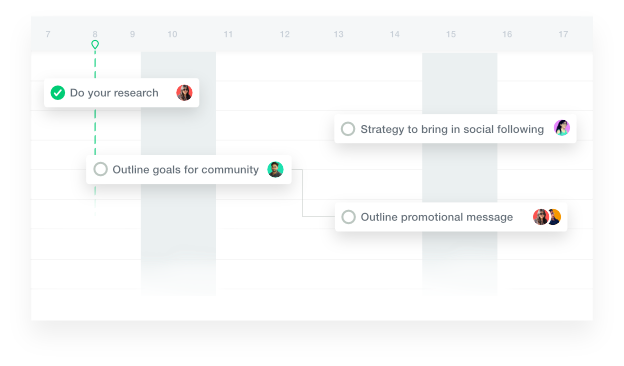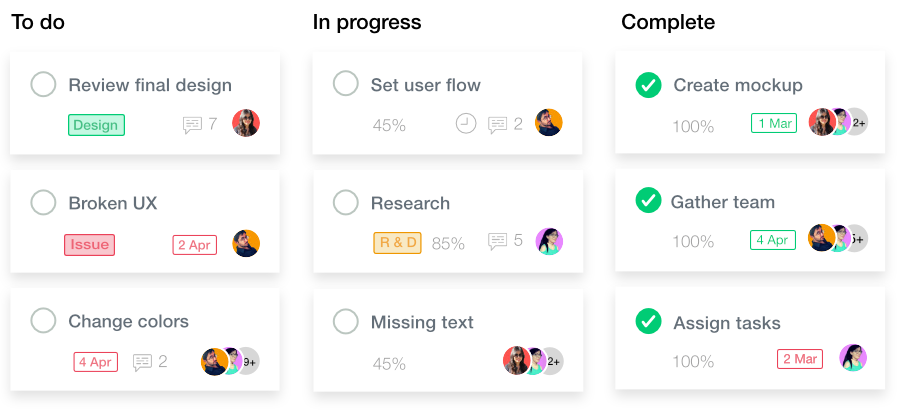“Task dependencies in project management”. I’m sure that this phenomenon is nothing new for project managers and their teams. However, if you’ve just started in the domain of project management then you need to understand project task dependencies in detail.
The domain of project management and human life have one common scenario – interdependence of various activities to meet our needs and build momentum to progress.
Whether it’s a small, straightforward project or a large, complex project, there will be a sequence in which tasks are supposed to be completed. Most (if not all) of these tasks are dependent on each other.
You’ll rarely come across a project in which all tasks are independent of each other.
This article is composed with the intention to help you understand what are task dependencies in project management, their vitality, their types, examples, and how to manage them effectively to deliver a project successfully.
Read on to know all about it.
Table of Contents
- What is task dependency in project management?
- Examples of task dependencies in project management
- Why do we need task dependencies in a project?
- What are different types of project task dependencies
- How you can manage task dependencies effectively with a robust project management software
- The final word
What is task dependency in project management?
Inter-dependent tasks in project management are those that rely on each other to be performed (completely or partially) before the next one could be started. Where there’s a task dependency, there’ll always be preceding and successive tasks; the latter depends on the former.

This can also be termed as a logical or preferential relationship between two activities or tasks. Let us take a look at some examples to easily understand this aspect of project management.
Examples of task dependencies in project management
Given below are some simple examples to exemplify the concept for beginners who are still coming to terms with project management and team collaboration.
Example 1: Content Creation And Approval
Content is the King in the domain of digital marketing but you cannot create and post content straightaway. You need a trending or evergreen topic to create content, proofread it, get it reviewed and approved, and then post it on your website (or on another platform). This way, one activity is dependent on the other.
You cannot start with an article or a blog until you finalize a topic. Once the topic is approved you create a draft and get it reviewed. Now, if the content is not approved during the review process, it will not be allowed to publish, and so on. So, you can see that all these tasks are dependent on each other.
Why do we need task dependencies in a project?

The task or project dependencies are crucial to its overall success. A project manager needs to set task dependencies to:
- Define the sequence of tasks in a project plan
- Figure out the critical path of tasks (how long each task is expected to take to be completed)
- Identify required resources and potential scheduling issues
- Monitoring and managing tasks within the project plan
- Avoid conflicts of scheduling
- Making adjustments in case of lags or advances
A constraint is a bottleneck or setback within the scope of an in-progress task.
These restrictions can be internal, like a lack of adequate resources in the form of money and a skilled workforce. Let’s say you need to assemble 10 PCs in a day but you only have one technician who cannot put together more than 5 PCs in a day. To assemble 10 PCs in a day, he would need additional tools to speed up the process.
Here, constraints are the lack of tools with the technician, and the task of assembling all 10 PCs in a day is therefore dependent on the technician’s ability to do it.
Constraints can also be external. For example, if you’re planning to get your house repainted, you need to hire a paint contractor to get the job done. Without it, you cannot start with your repainting project.
The aforementioned examples show that the constraints have given birth to the dependencies and vice-versa.
What are different types of project task dependencies
Project planning dependencies establish relationships among predecessor and successor tasks. There are different types of task dependencies in project management, which are listed below.
Causal Dependencies
Causal or logical task dependencies cannot be avoided. These dependencies occur naturally in the flow of tasks within a project. Without completing one task, you cannot initiate the next task in any way.
Resource-Based Dependencies
Resource-based task dependencies are constraints-driven. There is no causal dependency, which means that all tasks and activities can be completed together if all required resources are available.
Preferential Dependencies
Preferential dependencies are driven by optimal practices or convenience. Preferential dependencies focus on the quality of deliverables and are determined by the project manager and the project team.
External Dependencies
External task dependencies are those dependencies that are beyond the control of project managers and teams. External dependencies rely on third parties or outside vendors for completion.
Cross-Team Dependencies
Cross-team dependencies exist when two or more teams are required for delivering an end-to-end project. These dependencies present a stiff challenge to larger organizations.
Finish To Start (FS) Dependencies
This is probably the most common type of project task dependencies used in project management. In this case, task B depends on task A to get started. If task A is not completed satisfactorily then there’s no chance of task B getting started. For example, you cannot watch a football match in a stadium unless you buy a ticket first.
Finish To Finish (FF) Dependencies
FF task dependencies in project management mean that the successor task cannot be completed until the predecessor task is completed as well. For example, laying asphalt must finish before lane painting can be completed.
Start To Start (SS) Dependencies
SS task dependencies in project management mean that the successor task cannot be started until the predecessor task has begun. Two tasks need to start simultaneously. For example, a car race cannot start unless all cars have started racing.
Start To Finish (SF) Dependencies
SF task dependencies in project management are least frequently used. This means that the predecessor activity can only complete once the successor task has been initiated. For example, employees working in a day-shift cannot wrap up unless employees working in a night-shift are present at work.
“Sign up with the Ultimate Control Plan for $89 per month, billed annually and save 10%+34%. Hurry! Limited period offer.”
How you can manage task dependencies effectively with a robust project management software
Whether you’re a seasoned project manager or just started in a new role, you cannot expect to manage any project with task dependencies without using a powerful team collaboration and project management tool.
I’m stressing the word “powerful” here because not all project management tools can get the job done. Many PM tools have limited features, which makes them unsuitable to tackle task dependencies.
ProofHub is an award-winning project management software with all the right tools your team needs put under one roof. All your team members can share a common platform that further improves collaboration and simplifies project management.
Using various tools installed in different locations to manage task dependencies has proven to be a major challenge for project managers. ProofHub is designed and created to allow teams of any size, from any industry, to manage both easy and complex projects with utmost efficiency.
With inbuilt task management software and time tracking software, ProofHub enables project managers and their teams to deal with all challenges you might face. Whether you’re working on-site or remotely, you’ll always stay in the thick of things with ProofHub available for both desktop and mobile versions.
Let’s see how you can use ProofHub to manage task dependencies effectively.
Task Management Software

The task management software in ProofHub is the best thing that can happen to project managers today. Using this highly functional software, you can create, assign, and manage all your tasks in a single location, and monitor them even when you’re on the go.
Let’s see how task management software can be of great help to project managers and their teams.
- Creates tasks and assign them to individuals or groups, which ensures a clear distribution of responsibilities at one place
- Break large tasks into smaller and manageable subtasks, and define who works on what part
- Add custom labels to differentiate, organize, and prioritize tasks. You can filter similar tasks under one label
- Set start and due dates for tasks to make sure all team members are clear about priorities and deadlines
- Set time estimates to define how much time it should take to complete the task. You can also check if the time taken to complete a specific task exceeds the estimated time
- Track time spent on tasks manually or using timers, and save in timesheets
- Create recurring tasks if it needs to be done regularly and save time otherwise spent on adding such tasks manually
- Attach files and documents from your computer, Dropbox, Google Drive, One Drive, and Box to the tasks
- Review files, proof them, collaborate, and approve on them right where you are
- Control access and security
Gantt Charts

Use Gantt charts in ProofHub to have greater control over teams, projects, and resources easily. Gantt charts are designed to meet the needs of any organization irrespective of its size. These charts can be simple or complex, based on the nature of work your team is doing.
Gantt charts help you get a clear picture of all tasks, their progress, who’s working on what to make well-informed decisions, avoid bottlenecks, and manage resources efficiently.
Using Gantt charts, you can visualize and plan tasks, stay on top of your schedule, set task dependencies, and adjust your plans as work changes and deadlines shift. Read on more to discover how you can use Gantt charts to smartly manage task dependencies.
- Gantt charts help you visualize tasks in a timeline view so you can see the bigger picture and know how all tasks are progressing. You can push your workforce to deliver more if some tasks appear to be running behind schedule
- Add tasks and task lists to Gantt charts, and plan and schedule the order in which you want tasks to be completed
- Assign tasks or subscribe the entire task list to an individual or multiple people. Everyone knows who is supposed to work on what tasks, and by when
- Set dependencies between tasks and adjust schedules as work changes and deadlines shift
- Associate milestones with tasks and mark important dates such as desired completion dates and project review meetings on the project plan
- Track task progress in percentage to check how much work has been completed and how much is left
- Create private tasks lists in the Gantt chart to limit visibility only to selected people
- Drag and drop tasks in the Gantt chart to quickly change their start and due dates or duration
- Highlight critical path to see the status of tasks that directly affect the start and end date of a project
- Export Gantt charts in PDF and keep a documented record to use for resource management, planning, and scheduling
- Print Gantt charts and use them in meetings, planning, or scheduling projects accordingly
- Import tasks and task lists from CSV files
- Get Bird’s eye view of all Gantt chart data at one place without having to jump through projects
I hope things are crystal clear in your mind as to how an online Gantt chart tool in ProofHub makes it easier for you to update work schedules if there are any changes to it. You can change the order of tasks using the Gantt chart tool to manage task dependencies in project management.
“Stop wasting time, money, and resources on low-priority tasks and save your business from potential failure. Subscribe to ProofHub TODAY!”
Custom workflows and kanban boards

Besides the Gantt chart, another useful tool in ProofHub for managing task dependencies in project management is Kanban boards. What makes these boards efficient for handling task dependencies are its core principles – visualizing tasks at hand and seeing work moving through multiple stages.
According to a report, 90% of information that enters our brain is visual, and our brain processes visuals much faster than text. An additional benefit of visualizing workflow in Kanban boards is that it makes constraints and dependencies visible.
Another feature of Kanban boards that makes it easier to manage task dependencies in project management is managing lead time i.e. the time it takes for a single task to get completed, from the start to finish.
An unfavorable lead time can be attributed to long work processes and restrictions in the process. A Kanban board enables project managers and team members to visualize the work status and process constraints.
Dealing with task dependencies in project management with kanban boards
When it comes to managing task dependencies, there’s no one size-fits all approach. Many businesses combine different methodologies to serve their purpose. However, the Kanban offers a versatile way to tackle dependencies.
- Identify All Project Dependencies And Constraints
A visual tool like Kanban boards allow you to visualize workflows, better understand your work processes, identify complicated work stages, and get an overview of your workload. You may need to divide tasks into manageable subtasks so that the work continues to progress as planned. Once you identify potential project constraints, you’re in a better position to take required preemptive actions.
- Annotate Tasks
After identifying different task dependencies and restrictions, annotate tasks with the names of tasks that depend on it and ones it depends on. Knowing the sequence of requirements helps you and your team members ensure that all tasks are carried out in a consistent stream.
- Prioritize Tasks
Prioritize tasks based on schedules as some tasks become more relevant around specific dates. You can move such tasks lower or up on a scheduling calendar, depending up on their due dates.
- Customize Workflows
Project managers can customize the Kanban board by adding more columns to 3 basic columns of a standard workflow – to-do, in-progress, and done. You can also add horizontal swimlanes to view and track tasks dependencies in project management. This is useful in case you have a lot of external dependencies that are beyond your control.
- Record And Monitor Continuously
You can track each task dependency within a project to make sure that tasks are progressing while improving processes. You can track 4 things: total work in progress, blockers, throughput, and the lead time. Having this information will help project managers plan and schedule efficiently while minimizing risks.
The final word
The fact is that you cannot manage task dependencies in project management without leveraging technology. With its powerful features, ease of use, and minimal learning curve, a robust project management and team collaboration software like ProofHub can be your shot in the arm.
This cloud-based software with inbuilt features like Gantt chart, Kanban boards, and Task Management Software among others help you give greater control over all task dependencies from a single location.
Whether you’re working on-site or remotely, ProofHub will always have your back!
